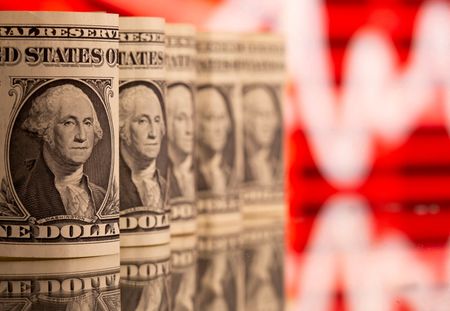
By Rae Wee
SINGAPORE (Reuters) – The dollar took a breather on Tuesday after a sweeping rally, easing slightly from milestone highs on the euro, yen and sterling, but not too far as recession stalk Europe and U.S. interest rates are poised for sharp rises.
The euro was up 0.4% to $0.9963 in early Asia trade after it hit a two-decade low of $0.9876 on Monday as the prospects for a winter without Russian gas sunk in.
Overnight trade was thinned by a holiday in the United States and on Tuesday the highlight of the Asia session will be a central bank meeting in Australia, where markets have priced about a 64% chance of a 50 basis point rate hike.
Russia has halted gas flow along the Nord Stream 1 pipeline to Germany indefinitely, at first blaming an oil leak at a compressor station but on Monday linking the stoppage to sanctions imposed by the west.
Sterling had hit a 2-1/2 year low of $1.1444 on the news, but rose 0.5% to $1.1585 in Asia. Liz Truss is Britain’s new Prime Minister after winning a leadership vote on Monday and her promises of tax cuts add uncertainty to government finances.
“Existential choices now need to be made, because there may not be enough energy to go round,” said Michael Every, global strategist at Rabobank.
“The choices are obviously unappetising.”
The dollar index fell 0.2% to 109.46 after rising as high as 110.27 on Monday. The yen, which has tumbled as U.S. rate hikes gather pace and widen the gap on anchored Japanese interest rates, last traded at 140.30 per dollar, not far from a 24-year trough of 140.80 hit last week.
Chinese authorities have stiffened their resistance to the dollar’s rise and late on Monday cut the foreign exchange reserve requirement ratio (RRR), freeing up dollars for banks to sell.
The move had only a limited effect on the exchange rate, with the yuan steady at 6.9412 in offshore trade.
The Australian and New Zealand dollars rose about 0.5% in morning trade, though analysts weren’t convinced a big rate hike in Australia would move the dial too far.
The Aussie was last 0.4% higher at $0.6826 and the kiwi rose 0.5% to $0.6121.
“In general, currency reactions to rate rises outside of the U.S. in recent months, even if they exceed expectations, don’t seem to have more than a temporary impact,” said National Australia Bank’s head of FX strategy, Ray Attrill.
“I think the key would be obviously in the language of the statement.”
(Reporting by Rae Wee; Editing by Shri Navaratnam)

